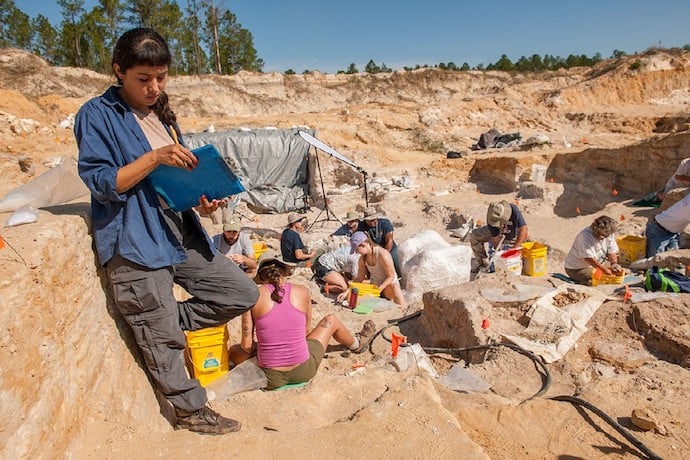Meet our Paleontology STEM Star, Michelle! Currently working on her MSc in paleontology, she is a grad student and Research Assistant at the Florida Museum of Natural History. We sat down with Michelle to ask about her work and field of study.
1. How did you originally get interested in paleontology?
I grew up visiting museums with my family nearly every weekend when I was a kid, and my favorite one to visit was the Los Angeles Museum of Natural History. The museums halls were filled with amazing objects from around the world, and I was fascinated by their stories, but it never occurred to me that there was a career behind each of those objects. When I grew up and went to college, I started my studies in business administration, but happened to take a GE geology class. Once I learned you could get paid to go hiking and look at rocks, I was sold! I switched my major that same semester, and one of the next classes I took was paleontology, where I learned that you could get paid to go hiking and look at fossils – sweet!
2. What is your typical day like?
A typical day of working at a natural history museum can range pretty widely, but mostly my job concerns the curation of fossils. Curation is the process of incorporating specimens into a museums collection, from sorting fossils from expeditions and donations, to cleaning and preparing them, to making them available for scientists to research. In addition to my work in curation, I also help with the excavation of our newest dig site, which has fossils that are 5 million years old!
3. What job do you hope to get after graduation?
Eventually, I would like to return to grad school and get a PhD, but first I’m going to take some time off. I have a few projects that have to stay on the back burner while I finish my masters, but I’m really excited to get them going after graduation!
4. What is the most common misconception about paleontology?
People often confuse paleontology for archaeology, and vice versa! It’s an understandable mistake, as our jobs are very similar and often overlap – we both study prehistory, and often use fossils to do so. However, the big difference is what section of time we study. Basically, archaeologists study everything after humans first appear in the fossil record, and paleontologists study everything before that!
5. What is the coolest thing your science studies have allowed you to do?
Travel! I’ve had the opportunity to visit five different countries in the past five years, more often than not fully funded, in order to do geology and paleontology field work. Among the expeditions have been mapping volcanic rocks in the Andes mountains of Argentina and digging up Miocene fossils along the banks of the Panama Canal.
6. Where can kids go that want to learn more about your field?
Books, museums, and social media! If you have access to a local natural history museum, you have access to not just paleontology but a whole range of cool science (that often intertwines!). Museums often host summer camps and special events where you can learn more about a particular field and get the opportunity to meet real scientists who study these fields. The museum gift shop would be a good place to start looking for books! A few paleontology books I would recommend are Dinosaur Empire by Abby Howard, any book from the Cartoon Prehistory of Life series by Hannah Bonner, and Daring to Dig: Adventures of Women in American Paleontology by Beth Stricker and Alana McGillis of the Paleontology Research Institute.
And finally, lots of paleontologists are actively sharing their work and research on social media; with the help and permission of a parent, you can see what paleontologists are up to on a day to day basis, and even get in contact with them! I recommend following Kallie Moore, collections manager of the University of Montana Paleontology Center, and Amy Atwater, who is the new curator at the Museum of the Rockies.
7. Can you also tell us a little about your podcast project and what inspired your to start it?
The Femmes of STEM podcast is a show that explores the history of women in STEM fields, recent to ancient times. Every episode, we feature the story of a new woman in science, and are joined by a modern woman in science to discuss their story. I love learning about history and I’m a podcast junkie, so I had been searching for a podcast like this for a while – when I couldn’t find it, I decided to make it myself! What I really love about having these stories of women, especially women of color, in STEM, is that it dispels the false narrative that we’re not a part of STEM. We’ve always been a part of the past, we just haven’t always been a part of history -Femmes of STEM is about changing that history.
Learn More
Femmes of STEM
About Paleontology
https://kidsdinos.com/paleontology/
http://www.dinosaursforkids.com/paleontology.html
Parenting Science: Paleontology and dinosaurs for kids
https://www.parentingscience.com/paleontology-for-kids-reviews.html
https://www.parentingscience.com/dinosaurs-for-kids.html

